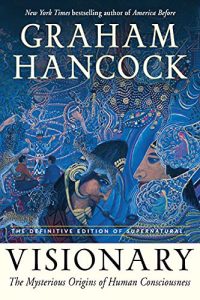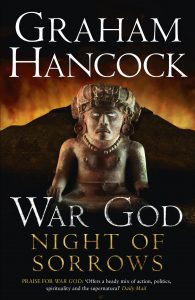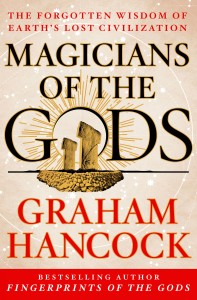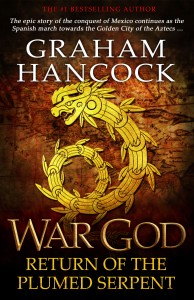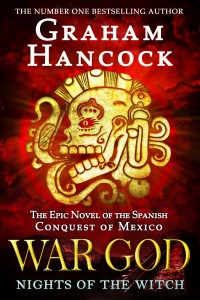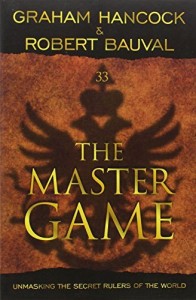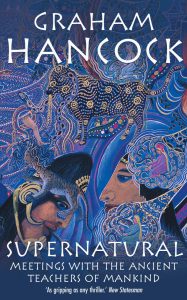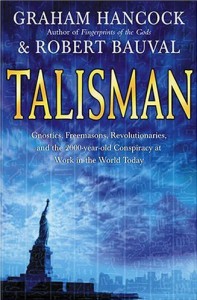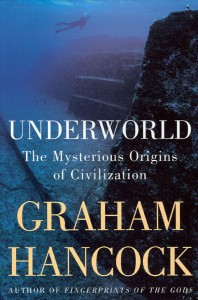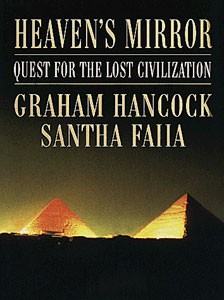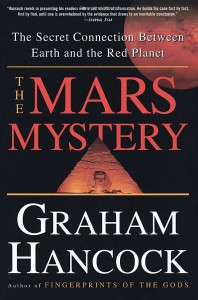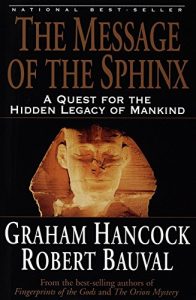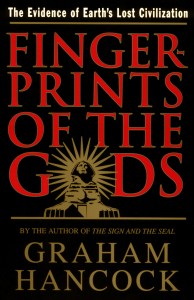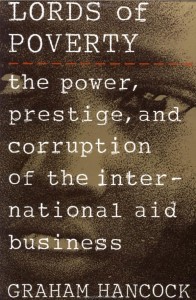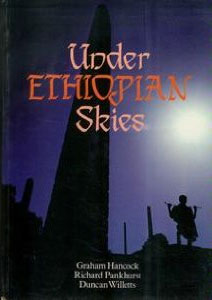The Sign And The Seal (1992)
by Graham Hancock
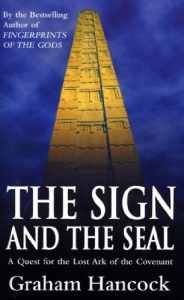
“Added to the Holy Grail excitement of the quest, he has invented a new genre: an intellectual whodunit by a do-it-yourself sleuth.”
The Guardian
A journalist and travel writer in the employ of the Ethiopian government in the early 1980’s hears mention that the great lost treasure of the Jewish race – the ark of the covenant in which Moses placed the ten commandments – is reputed to be held in a church somewhere in Ethiopia …
The same man later sees the Hollywood blockbuster ‘Raiders of the lost Ark’, and an idea begins to find shape in his mind which will take some years to come to fruition …
In 1989 at Chartres Cathedral, France, he is drawn to a small, seemingly insignificant carving which mysteriously hints that the tale he heard in Ethiopia may be true – that that may, in fact, be the last resting place of the Ark …
The man is Graham Hancock – and the story of his quest to discover the truth behind the legends is the breathtaking real life adventure of The Sign and The Seal. the book that launched Graham into the bestseller lists worldwide.
Following obscure clues found within ancient stories and Biblical tales, through the occult knowledge gleaned from the coded Grail epic of Wolfram Von Eschenbach, and the obscure and secretive workings of the enigmatic Knights Templar, Graham traces the Ark from its source in ancient Egypt, to Jerusalem, and from there to its final resting place in Africa.
This is a tale worthy of Indiana Jones himself! A real modern day quest set against the lost knowledge of the ancient world and the political intrigues of the contemporary one.
Here is the first inkling that the technology of ancient Egypt, that produced the Ark, was something mysterious and powerful – a legacy, perhaps of something older and forgotten – here is the seeds that would flower in Fingerprints of the Gods. Was Moses an initiate of the lost Egyptian wisdom – the lost wisdom of the survivors of a cataclysmic flood?
A deeply personal account of a quest for meaning, The Sign and the Seal is a must-read for any interested in the ancient world or in the genesis of Graham Hancock’s thinking.
Chapter 1
INITIATION: 1983
It was growing dark and the air of the Ethiopian highlands was chill when the monk appeared. Stooped and leaning on a prayer stick he shuffled towards me from the doorway of the sanctuary chapel and listened attentively as I was introduced to him. Speaking in Tigrigna, the local language, he then sought clarification through my interpreter about my character and my motives: from which country had I come, what work did I do there, was I a Christian, what was it that I wanted from him?
I answered each of these questions fully, squinting through the gloom as I talked, trying to make out the details of my inquisitor’s face. Milky cataracts veiled his small sunken eyes and deep lines furrowed his black skin. He was bearded and probably toothless — for although his voice was resonant it was also oddly slurred. All I could be sure of, however, was that he was an old man, as old as the century perhaps, that he had his wits about him, and that he did not seem to be seeking information about me out of idle curiosity. Only when he was satisfied with everything that I had said did he condescend to shake hands with me. His grip was dry and delicate as papyrus and from the thick robes that he wore, faint but unmistakable, arose the holy odour of frankincense.
Now that the formalities were over I got straight to the point. Gesturing in the direction of the building that loomed in shadowy outline behind us, I said: ‘I have heard of an Ethiopian tradition that the Ark of the Covenant is kept here . . . in this chapel. I have also heard that you are the guardian of the Ark. Are these things true?’
‘They are true.’
‘But in other countries nobody believes these stories. Few know about your traditions anyway, but those who do say that they are false.’
‘People may believe what they wish. People may say what they wish. Nevertheless we do possess the sacred Tabot, that is to say the Ark of the Covenant, and I am its guardian…’
‘Let me be clear about this,’ I interjected. ‘Are you referring to the original Ark of the Covenant — the box made of wood and gold in which the Ten Commandments were placed by the prophet Moses?’
‘Yes. God Himself inscribed the ten words of the law upon two tablets of stone. Moses then placed these tablets inside the Ark of the Covenant — which afterwards accompanied the Israelites during their wanderings in the wilderness and their conquest of the Promised Land. It brought them victory wherever they went and made them a great people. At last, when its work was done, King Solomon placed it in the Holy of Holies of the Temple that he had built in Jerusalem. And from there, not long afterwards, it was removed and brought to Ethiopia…’
‘Tell me how this happened,’ I asked. ‘What I know of your traditions is only that the Queen of Sheba is supposed to have been an Ethiopian monarch. The legends I have read say that when she made her famous journey to Jerusalem she was impregnated by King Solomon and bore him a son — a royal prince — who in later years stole the Ark…’
The monk sighed. ‘The name of the prince you are speaking of was Menelik — which in our language means “the son of the wise man”. Although he was conceived in Jerusalem he was born in Ethiopia where the Queen of Sheba had returned after discovering that she was carrying Solomon’s child. When he had reached the age of twenty, Menelik himself travelled from Ethiopia to Israel and arrived at his father’s court. There he was instantly recognized and accorded great honour. After a year had passed, however, the elders of the land became jealous of him. They complained that Solomon showed him too much favour and they insisted that he must go back to Ethiopia. This the king accepted on the condition that the first-born sons of all the elders should also be sent to accompany him. Amongst these latter was Azarius, son of Zadok the High Priest of Israel, and it was Azarius, not Menelik, who stole the Ark of the Covenant from its place in the Holy of Holies in the Temple. Indeed the group of young men did not reveal the theft to Menelik until they were far away from Jerusalem. When at last they told him what they had done he understood that they could not have succeeded in so bold a venture unless God had willed it. Therefore he agreed that the Ark should remain with them. And it was thus that it was brought to Ethiopia, to this sacred city … and here it has remained ever since.’
‘And are you telling me that this legend is literally true?’
‘It is not a legend. It is history.’
‘How can you be so sure of that?’
‘Because I am the guardian. I know the nature of the object that has been placed in my care.’
We sat in silence for a few moments while I adjusted my mind to the calm and rational way in which the monk had told me these bizarre and impossible things. Then I asked him how and why he had been appointed to his position. He replied that it was a great honour that he should have been chosen, that he had been nominated with the last words of his predecessor, and that when he himself lay on his death-bed his turn would come to nominate his own successor.
‘What qualities will you look for in that man?’
‘Love of God, purity of heart, cleanliness of mind and body.’
‘Other than you,’ I asked next, ‘is anyone else allowed to see the Ark?’
‘No. I alone may see it.’
‘So does that mean that it is never brought out of the sanctuary chapel?’
The guardian paused for a long while before answering this question. Then, finally, he told me that in the very distant past the relic had been brought out during all the most important church festivals. More recently its use in religious processions had been limited to just one occasion a year. That occasion was the ceremony known as Timkat which took place every January.
‘So if I come back next January will I have a chance of seeing the Ark?’
The monk looked at me in a way that I found strangely disconcerting and then said: ‘You must know that there is turmoil and civil war in the land . . . Our government is evil, the people oppose it, and the fighting comes closer every day. In such circumstances it is unlikely that the true Ark will be used again in the ceremonies. We cannot risk the possibility that any harm might come to something so precious . . . Besides, even in time of peace you would not be able to see it. It is my responsibility to wrap it entirely in thick cloths before it is carried in the processions . .
‘Why do you wrap it?’
‘To protect the laity from it.’
I remember asking my interpreter to clarify the translation of this last puzzling remark: had the monk really meant ‘to protect the laity from it’? Or had he meant ‘to protect it from the laity’?
It was some time before I got my answer. ‘To protect the laity from it. The Ark is powerful.’
A GREAT MYSTERY OF THE BIBLE
In early Old Testament times the Ark of the Covenant was worshipped by the Israelites as the embodiment of God Himself, as the sign and the seal of His presence on earth, as the stronghold of His power, and as the instrument of His ineffable will.(1) Built to contain the tablets of stone upon which the Ten Commandments had been written, it was a wooden chest measuring three feet nine inches long by two feet three inches high and wide.(2)It was lined inside and out with pure gold and was surmounted by two winged figures of cherubim that faced each other across its heavy golden lid.(3)
Biblical and other archaic sources speak of the Ark blazing with fire and light, inflicting cancerous tumours and severe burns, levelling mountains, stopping rivers, blasting whole armies and laying waste cities. The same sources also leave no doubt that it was, for a very long time, the cornerstone of the evolving Jewish faith: indeed when King Solomon built the First Temple in Jerusalem his sole motive was to create ‘an house of rest for the Ark of the Covenant of the Lord'(4) At some unknown date between the tenth and the sixth century BC, however, this uniquely precious and puissant object vanished from its place in the Holy of Holies of that Temple, vanished without song or lamentation in the Scriptures — almost as though it had never existed at all. The evidence suggests that it was already long gone when the armies of Nebuchadnezzar burned Jerusalem in 587 BC. Certainly it was not in the Second Temple which was built over the ruins of the First after the Jews had returned from their exile in Babylon in 538 BC. Neither does it seem to have been taken as booty by the Babylonians.
Writing in 1987, Richard Elliott Friedman, Professor of Hebrew and Comparative Religion at the University of California, expressed a view shared by many scholars when he described the disappearance of the sacred relic as ‘one of the great mysteries of the Bible’:
There is no report that the Ark was carried away or destroyed or hidden. There is not even any comment such as ‘And then the Ark disappeared and we do not know what happened to it’ or ‘And no one knows where it is to this day’. The most important object in the world, in the biblical view, simply ceases to be in the story.'(5)
Indeed so. A close reading of the Old Testament reveals more than two hundred separate references to the Ark of the Covenant up until the time of Solomon (970-931 BC); after the reign of that wise and splendid king it is almost never mentioned again.(6) And this, surely, is the central problem, the real historical enigma: not, human nature being what it is, that an immensely valuable golden chest should go missing, but — given its supreme religious significance — that it should go missing amidst such a deafening, improbable silence. Like a black hole in space, or a negative photographic image, it is identifiable in the later books of the Old Testament only by what it is not — it is, in short, conspicuous only by its absence.
From this it seems reasonable to suggest that some sort of cover-up may have taken place — a cover-up devised by priests and scribes to ensure that the whereabouts of the sacred relic would remain forever a secret. If so then it is a secret that many have tried to penetrate — a secret that has inspired several treasure-hunting expeditions (all of which have failed) and also one enormously successful Hollywood fantasy, Raiders of the Lost Ark, which was first released in the USA and Europe in 1981 with Harrison Ford in the starring role as Indiana Jones.
I was living in Kenya at the time and had no opportunity to see the film until it finally arrived in Nairobi’s cinemas early in 1983. I enjoyed the combination of action, adventure and archaeology and I remember thinking what a sensation it would be if someone were really to find the Ark. Then, only a few months later, I made an extended visit to Ethiopia during which I travelled to the north-west of the war-torn province of Tigray. It was there, in Axum — the so-called ‘sacred city of the Ethiopians'(7) — that I had my encounter with the guardian monk reported earlier in this chapter.
1983: A COUNTRY AT WAR
On 28 May 1991, after years of brutal fighting, the government of Ethiopia was finally toppled by a formidable coalition of rebel forces in which the Tigray People’s Liberation Front had played a leading role. When I went to Axum in 1983, however, the TPLF was still a relatively small guerilla force and the sacred city, although besieged, was still in government hands. Other than myself, no foreigners had been there since 1974 when a team of British archaeologists had been driven out by the revolution that had overthrown Emperor Haile Selassie and that had installed one of Africa’s bloodiest dictators, Lieutenant-Colonel Mengistu Haile Mariam, as Head of State.
Lamentably the free access that I was granted to Axum did not result from any special enterprise or initiative of my own but from the fact that I was working for Mengistu. As a result of a business deal that I was later bitterly to regret I was engaged in 1983 in the production of a coffee-table book about Ethiopia — a book that Mengistu’s government had commissioned in order to proclaim the underlying unity in the country’s cultural diversity, and to emphasize the ancient historical integrity of the political boundaries that the rebels were trying so hard to redraw. It had been agreed before I began work that there would be no overt promotion of the government’s cause, and it was written into my contract that no particular individuals (Mengistu included) would be praised or vilified. Nevertheless I was under no illusions about how the project was viewed by senior figures in the regime: they would not have footed the bills, or permitted me to visit historic sites forbidden to others, if they did not think that what I was doing would be helpful to them.
Even so it was by no means easy for me to get to Axum. Intense rebel activity along the main roads and around the sacred city itself meant that driving was completely out of the question. The only option, therefore, was to fly in. To this end — together with my wife and researcher Carol and my photographer Duncan Willetts — I travelled first to Asmara (the regional capital of Eritrea) where I hoped that it might be possible for us to hitch a ride over the battle lines on one of the many military aircraft stationed there.
Standing on a high and fertile plateau overlooking the fearsome deserts of the Eritrean coastal strip, Asmara is a most attractive place with a markedly Latin character — not surprising since it was first occupied by Italian forces in 1889 and remained an Italian stronghold until the decolonization of Eritrea (and its annexation by the Ethiopian state) in the 1950s.(8) Everywhere we looked we saw gardens erupting with the colour of bougainvillaea, flamboyants and jacaranda, while the warm, sunny air that surrounded us had an unmistakable Mediterranean bouquet. There was also another element that was hard to miss: the presence of large numbers of Soviet and Cuban combat ‘advisers’ wearing camouflage fatigues and carrying Kalashnikov assault rifles as they swaggered up and down the fragrant pastel-shaded boulevards.
The advice that these thickset men were giving to the Ethiopian army in its campaign against Eritrean separatists did not, however, appear to us to be very good. Asmara’s hospitals were crammed to bursting point with casualties of the war and the government officials we met exuded an air of pessimism and tension.
Our concerns were heightened a few nights later in the bar of Asmara’s rather splendid Ambasoira Hotel where we met two Zambian pilots who were on temporary secondment to Ethiopian Airlines. They had thought that they were going to be spending six months expanding their practical experience of commercial flying. What they were actually doing, however, was ferrying to Legend injured soldiers from the battle fronts in Tigray and Eritrea to the hospitals in Asmara. They had tried to get the airline to release them from this hazardous duty; on checking the small print of their contracts, however, they had discovered that they were bound to do it.
After several weeks of almost continuous sorties in aged DC3 passenger planes converted to carry wounded troops, the two pilots were shell-shocked, shaky and embittered. They told us that they had both taken to the bottle to drown their sorrows: ‘I can’t sleep at night unless I’m completely drunk,’ one of them confided. ‘I keep getting these pictures passing through my mind of the things that I’ve seen.’ He went on to describe the teenage boy who, that morning, had been dragged aboard his aircraft with his left foot blown away by a mine, and another young soldier who had lost half his skull after a mortar bomb had exploded nearby. ‘The shrapnel wounds are the worst . . . people with huge injuries in their backs, stomachs, faces . . . it’s horrible .. . sometimes the whole cabin is just swilling with blood and guts… we carry as many as forty casualties at a time — way above the operating limits of a DC3, but we have to take the risk, we can’t just leave those people to die.’ each day, the other pilot now added. In the past week he had been twice to Axum and on both occasions his plane had been hit by machine-gun fire. ‘It’s a very difficult airport — a gravel runway surrounded by hills. The TPLF just situp there and take pot-shots at us as we land and take off. They’re not fooled by the Ethiopian Airlines livery. They know we’re on military business . .
Overjoyed to have found some sympathetic non-Russian and non-Cuban foreigners to share their woes with, the Zambians had not yet asked us what we were doing in Ethiopia. They did so now, and seemed highly amused when we replied that we were producing a coffee-table book for the government. We then explained that we needed to get to Axum ourselves.
‘Why?’ they asked, dumbfounded.
‘Well, because it’s one of the oldest and most important archaeological sites and because it was there that Ethiopian Christianity first got started. It was the capital for hundreds of years. Our book’s going to look really sick without it.’
Initiation
‘We might be able to take you,’ one of the pilots now suggested.
‘What — you mean when you next go to pick up wounded?’
‘No. You definitely wouldn’t be allowed on those flights. But a delegation of military top brass are supposed to be going there the day after tomorrow to inspect the garrison. Maybe you could hitch a ride then. It would depend on what sort of strings you’re able to pull back in Addis. Why don’t you check it out?’
INTO AXUM
We spent most of the next day on the telephone to Addis Ababa talking to the minister directly responsible for our project. It was touch and go, but his influence finally did get us seats on the flight that our Zambian friends had told us about. In the event, however, they were not to be our pilots; a fully Ethiopian crew was on board the DC3 for the short hop to Axum.
During the one-hour delay before our morning take-off from Asmara airport, and during the turbulent thirty-five-minute journey itself, I completed my background reading reassuring myself in the process that the visit really was worthwhile.
The early historical references painted a picture of an important and cosmopolitan urban centre. In AD 64, for example, the anonymous author of a Greek trading manual known as the Periplus of the Erythrean Sea had referred to the Axumite ruler as being ‘a prince superior to most and educated with a knowledge of Greek’.(9) Some hundreds of years later a certain Julian, ambassador of the Roman Emperor Justinian, described Axum in glowing terms as ‘the greatest city of all Ethiopia’. The king, he added, was almost naked, wearing only a garment of linen embroidered with gold from his waist to his loins and straps set with pearls over his back and stomach. He wore golden bracelets on his arms, a golden collar around his neck, and on his head a linen turban — also embroidered with gold — from which hung four fillets on either side. When receiving the ambassador’s credentials, this monarch apparently stood on a four-wheeled chariot drawn by four elephants; the body of the chariot was high and covered with gold plates.’
In the sixth century AD, a much-travelled Christian monk, Cosmas Indicopleustes, added further colour to the impression conveyed by Julian. After his visit to the city he reported that the ‘four-towered palace of the King of Ethiopia’ was adorned with ‘four brazen figures’ of a unicorn, as well as the skin of a rhinoceros ‘stuffed with chaff’. He also saw several giraffes which had been caught ‘by command of the King when young and tamed to make a show for his amusement’.(11)
These images of barbaric splendour well befitted the capital of what had by that time become the most important power between the Roman Empire and Persia — a power that sent its merchant navies as far afield as Egypt, India, Ceylon and China and that had adopted Christianity as its state religion as early as the fourth century AD.
The story of the conversion of Ethiopia is preserved in the writings of the fourth-century Byzantine theologian Rufinius — an authority highly regarded by modern historians. Apparently a certain Meropius, a Christian merchant described by Rufinius as a ‘philosopher of Tyre’, once made a voyage to India, taking with him two Syrian boys whom he was educating in ‘humane studies’. The elder was called Frumentius and the younger Aedesius. On their return journey through the Red Sea the ship was seized off the Ethiopian coast in an act of reprisal against the Eastern Roman Empire which had broken a treaty with the people of the area.
Meropius was killed in the fighting. The boys, however, survived and were taken to the Axumite King, Ella Amida, who promptly made Aedesius his cup-bearer and Frumentius — the more sagacious and prudent of the two — his treasurer and secretary. The boys were held in great honour and affection by the king who, however, died shortly afterwards leaving his widow and an infant son — Ezana — as his heir. Before his death, Ella Amida had given the two Syrians their freedom but now the widowed queen begged them, with tears in her eyes, to stay with her until her son came of age. She asked in particular for the help of Frumentius — for Aedesius, though loyal and honest at heart, was simple.
During the years that followed, the influence of Frumentius in the Axumite kingdom grew. He sought out such foreign traders who were Christians and urged them ‘to establish conventicles in various places to which they might resort for prayer.’ He also provided them with ‘whatever was needed, supplying sites for buildings and in every way promoting the growth of the seed of Christianity in the country.’
At around the time that Ezana finally ascended the throne, Aedesius returned to Tyre. Frumentius for his part journeyed to Alexandria, in Egypt — then a great centre of Christianity — where where he informed Patriarch Athanasius of the work so far accomplished for the faith in Ethiopia. The young man begged the ecclesiastical leader ‘to look for some worthy man to send as bishop over the many Christians already congregated.’ Athanasius, having carefully weighed and considered the words of Frumentius, declared in a council of priests: ‘What other man shall we find in whom the spirit of God is as in thee who can accomplish these things?’ He therefore ‘consecrated him and bade him return in the Grace of God whence he came.'(12)
Frumentius accordingly went back to Axum as Ethiopia’s first Christian bishop and there he continued his missionary endeavours — which were rewarded, in the year AD 331, by the conversion of the king himself. The surviving coins of Ezana’s reign record the transition: the earlier ones bear crescent and disk images of the new and full moon; later examples are stamped uncompromisingly with the cross — amongst the earliest coins of any country to carry this Christian symbol.'(13)
Important as the seed-bed of Ethiopian Christianity — and as the capital of the Ethiopian empire from the first until approximately the tenth century AD — Axum’s interest in terms of our project was nevertheless much broader than this. Here, I read, we would come across many imposing pre-Christian ruins of great archaeological merit (including the remains of several immense palaces), and also — still well preserved — the monuments for which the city was best known: its ancient obelisks, some more than two thousand years old, attesting to a high level of advancement in art and architecture at a date far earlier than that of any other civilization in sub-Saharan Africa. Nor were such physical artefacts the only witnesses to Axum’s unique stature. To my astonishment, the reference works I had with me reported that according to Ethiopian legends the Ark of the Covenant was kept here in a small chapel adjacent to an especially sacred church. The legends were connected to Ethiopia’s claim to have been the realm of the biblical Queen of Sheba but were generally dismissed by historians as preposterous fictions.
Having only recently seen the first Indiana Jones movie, Raiders of the Lost Ask, I was naturally intrigued by the possibility — however remote — that the most precious and mystical relic of Old Testament times, a relic believed to have been lost for almost three thousand years, might actually rest in the city I was about to visit. I therefore decided that I would not leave without learning more about this strange tradition and I looked down with renewed interest when the captain announced that Axum was directly beneath us.
The DC3’s descent to the narrow runway far below was unorthodox in the extreme — and quite alarming. Instead of the usual long, low and slow approach, the pilot brought the plane down very fast from a considerable altitude in a tight corkscrew pattern that kept us at all times directly above the town. This, one of the military men riding with us explained, was so as to minimize the time that we would be a target for snipers in the surrounding hills. I remembered what the Zambians had said about regularly getting hit by machine-gun fire when landing at Axum and prayed silently that this would not happen to us. It was an unpleasant feeling to be strapped into a flimsy seat in a narrow tube of metal hundreds of feet above the ground and to wonder whether, at any moment, bullets were going to start plunking through the cabin floor and walls.
Fortunately nothing so bad happened that morning and we touched down safely. I remember the red gravel of the strip, the dust that flew up as the wheels made contact, and the sight of large numbers of Ethiopian soldiers — all armed to the teeth and dressed in combat fatigues — staring at us intently as we taxied to a halt. I noticed other things as well: trenches had been dug on both sides of the runway and there were numerous pits, covered with camouflage netting, out of which protruded the barrels of heavy artillery pieces. I recall several armoured personnel carriers lined up near the tower and perhaps half-a-dozen Soviet tanks. Parked off to one side, on the apron, there were also two Mi-24 helicopter gunships with rocket pods visible beneath their stubby stabilizing fins.
From the beginning to the end of our visit, Axum never for a second shed the jittery and watchful atmosphere of a city under siege. We were permitted to stay only one night but we felt as though our time there was drawn-out, protracted, almost infinite.
PALACES, CATACOMBS AND OBELISKS
Our work began the moment that we arrived. Waiting to greet us as we stepped down from the plane was an elderly Abyssinian gentleman wearing a slightly threadbare three-piece suit and a most splendid patriarchal beard. In quaint but excellent English, he introduced himself as Berhane Meskel Zelelew and explained that he had been contacted by radio from Addis Ababa and ordered to guide us and act as our interpreter. He was employed, he said, by the Ministry of Culture ‘to keep an eye on the antiquities of Axum’. In this capacity he had helped the archaeologists from the British Institute in Eastern Africa whose excavations of some of the city’s most interesting ruins had been interrupted by the revolution of 1974.(14) ‘It’s so nice to see other British people here after such a long time,’ he exclaimed as we introduced ourselves.
We climbed into a vintage Land Rover with a lime-green paint job and two neat bullet holes in the front windscreen. ‘Fortunately no one was killed,’ Zelelew reassured us when we asked him about these. Laughing nervously as we drove away from the airfield, I then explained what we had come to do, listed the historic sites that we wanted to visit, and told him that I was particularly intrigued by Axum’s claim to be the last resting place of the Ark of the Covenant.
‘Do you believe that the Ark is here?’ I asked.
‘Yes. Certainly.’
‘And where is it exactly?’
‘It is deposited in a chapel near the centre of the city.’
‘Is this chapel very old?’
‘No. Its construction was ordered by our late Emperor . . . in 1965 I think. Before that the relic had rested for many hundreds of years within the Holy of Holies of the nearby church of Saint Mary of Zion . . Zelelew paused, then added: ‘Haile Selassie had a special interest in this matter, by the way . . . He was the two hundred and twenty-fifth direct-line descendant of Menelik, son of the Queen of Sheba and King Solomon. It was Menelik who brought the Ark of the Covenant to our country . .
I was all for visiting the chapel at once, but Zelelew persuaded me that there was little point in hurrying: ‘you will not be allowed anywhere near the Ark. Where it rests is holy ground. The monks and the citizens of Axum protect it and they would not hesitate to kill anyone who tried to break in. Just one man is allowed to enter and he is the monk responsible for guarding the Ark. We will try to meet him later today, but first let us go and see the Queen of Sheba’s palace.’
After we had assented to this attractive proposition we turned on to a bumpy, potholed road that — had we been able to follow it all the way — would eventually have led us hundreds of miles south-west, through the gigantic peaks and valleys of the Simien mountains, to the city of Gondar near Lake Tana. In open country barely a mile from the centre of Axum, however, we stopped within sight of an extensively fortified military post which, Zelelew explained, marked the limit of the government-controlled sector. He waved expressively at the nearby hills: ‘Everything else TPLF, so we cannot go. It’s a pity. There are so many interesting things to see . . . There, just around that corner in the road, are the granite quarries where all the stelae were cut. One still remains partially unexcavated from the rock. And there is a beautiful carving of a lioness. It is very ancient. It was put there before the coming of Christianity. But unfortunately we cannot reach it.’
‘How far is it exactly?’ I asked, tantalized.
‘Very close, less than three kilometres. But the military will not let us past the checkpoint and if they did we would certainly be taken by the guerillas. Even here we should not stand around for too long. Your foreign faces will be noticed by the TPLF snipers. They might think you are Russians and decide to shoot at you . . .’ He laughed: ‘That would be highly undesirable, would it not? Come, follow me.’
He led the way into fields to the north of the road and we quickly began to stumble across the remains of what must, once, have been an imposing building. ‘This was the Queen of Sheba’s palace,’ Zelelew announced proudly. ‘According to our traditions her name was Makeda and Axum was her capital. I know that foreigners do not accept that she was an Ethiopian at all. Nevertheless no other country has a stronger claim than ours.’
I asked whether any archaeology had ever been done on the site to test the legends.
‘Yes, in the late 1960s the Ethiopian Institute of Archaeology conducted some excavations here . . . I helped on the dig.’
‘And what was discovered?’
Zelelew made a mournful face. ‘The opinion was that the palace was not sufficiently old to have been the residence of the Queen of Sheba.’
What the archaeologists had unearthed, and what we now spent some time exploring, were the ruins of a great and well built edifice with finely mortared stone walls, deep foundations and an impressive drainage system. We saw a still-intact flagstone floor — which Zelelew claimed was a large throne room — and a number of stair-wells which hinted at the existence of at least one upper storey. There were also private bathing areas of sophisticated design and a well-preserved kitchen dominated by two brick ovens.
Across the road, in a field facing the palace, we then inspected a number of rough-hewn granite stelae, some standing more than fifteen feet high, some fallen and broken. Most were undecorated but one, the largest, was carved with four horizontal bands, each band topped by a row of circles in relief — like protruding beam ends in a building made of wood and stone. This crude obelisk, Zelelew told us, was thought by the townspeople to mark the grave of the Queen of Sheba. No excavation work had been carried out beneath it, however, and the field was now entirely given over to farmers who grew crops for the Axum garrison. Even as we talked we saw two peasant boys approach with an ox, which they harnessed to a wooden plough. Oblivious to the history that lay all around them, and apparently indifferent to our presence as well, they began to till the soil.
After we had finished taking pictures and notes we drove back into the centre of the city and then out again to the north-east to another palace complex, this one on a hill-top with commanding views of the whole area. Square in plan, the structure measured about two hundred feet on each side. The walls, which had long since crumbled, showed signs of having originally been projected at the corners to form four towers — possibly the very towers which, in the sixth century, the monk Cosmas had described as being adorned with brass unicorns.
Beneath the fortress Zelelew then led us down steep stone stairways into a number of underground galleries and chambers which were roofed and walled with massive dressed granite blocks that fitted precisely against one another without any mortar in the joints. Local tradition, he said, identified this cool dark warren as the treasury used by Emperor Kaleb (AD 514 — 542) and also by his son Gebre-Maskal. With the aid of a flashlight we saw the empty stone coffers which lay within — coffers believed to have once contained great riches in gold and pearls.(15) Further rooms, as yet unexcavated, extended into the hillside from there, blocked off behind thick granite walls.
Eventually we left the hill-top fortress and made our way down into the centre of Axum on a gravel road. Near the bottom of the gradient, to our left, we paused to photograph a large, open deep-water reservoir dug down into the red granite of the hillside and approached by means of rough-hewn stairways. Known as the Mai Shum, it seemed to us very old — an impression that Zelelew confirmed when he remarked that it was originally the Queen of Sheba’s pleasure bath: ‘At least so our people believe. Since the beginning of Christian times it has been used for baptismal ceremonies to celebrate the Holy Epiphany, which we call Timkat. And of course the peasants still come here every day to draw their water.’ As though to confirm this last observation he pointed to a group of women carefully descending the time-worn steps bearing gourds on their heads.
By now, without any of us really noticing how the time had passed, it was already well past the middle of the afternoon. Zelelew urged us to hurry, pointing out that we were scheduled to fly back to Asmara at first light the next day and that we still had much to see.
Our next destination was close by, the so-called ‘Park of the Stelae’ — certainly the focal point of Axum’s archaeological interest. Here we examined and photographed a remarkable series of giant obelisks carved from slabs of solid granite. The most massive of these, a tumbled fractured ruin, was believed to have fallen to the ground more than a thousand years previously. In its heyday, though, it had stood one hundred and ten feet tall and must have dominated the entire area. I remembered from the reading I had done on the flight that its weight was estimated to exceed five hundred tons. It was thought to be the largest single piece of stone ever successfully quarried and erected in the ancient world.
This fallen stele was painstakingly hewn to mimic a high, slender building of thirteen storeys — each storey complete with elaborate representations of windows and other details, and demarcated from the next by a row of symbolic beam-ends. At the base could be discerned a false door complete with a knocker and lock, all perfectly carved in stone.
Another fallen — but much smaller and unbroken — obelisk, Zelelew told us, had been stolen during the Italian occupation of 1935-41, transported with enormous difficulty to Rome by Mussolini, and re-erected near the Arch of Constantine. Since it, too, was elaborately carved — and therefore of great artistic value — the Ethiopian government was campaigning for its return. In the meantime, however, it was fortunate that a third decorated monolith still remained in situ in the stelae park.
With a flourish our guide now pointed to this towering stone needle, more than seventy feet high and topped with a curved headpiece shaped like a half moon. We strolled over to examine it properly and found that, like its huge neighbour, it had been carved to resemble a conventional built-up structure — in this case a nine-storey building in the fashion of a tower-house. Once again, the main decoration on the front elevation was provided by the semblance of windows and of beams of timber supposedly inserted horizontally into the walls. The intervals between each of the floors were defined by rows of symbolic log-ends, and the house-like appearance was further enhanced by the presence of a false door.
Several other stelae of varying sizes were ranged around this refined monument — all of them clearly the products of an advanced, well organized and prosperous culture. Nowhere else in sub-Saharan Africa had anything even remotely similar been built and, for this reason, Axum was a mystery — its antecedents unknown, the sources of its inspiration unremembered.
THE SANCTUARY CHAPEL
Across the road, directly opposite the park of the stelae, stood a spacious walled compound containing two churches — one old and the other obviously much more recent. These, Zelelew told us, were both dedicated to Saint Mary of Zion. The new one, which had a domed roof and a lofty bell-tower in the shape of an obelisk, had been built by Haile Selassie in the 1960s. The other dated back to the mid-seventeenth century and was the work of Emperor Fasilidas — who, like so many Ethiopian monarchs before and since, had been crowned in Axum and had venerated the sacred city despite making his capital elsewhere.
We found Haile Selassie’s pretentious modern ‘cathedral’ as unpleasant as it was uninteresting. We were attracted, however, to the Fasilidas construction which, with its turrets and crenellated battlements, seemed to us ‘half church of God, half castle’ — and thus to belong to a truly ancient Ethiopian tradition in which the distinctions between the military and the clergy were often blurred.
In the dimly lit interior I was able to study several striking murals including one depicting the story of the life of Mary, another that of the Crucifixion and Resurrection of Christ, and a third the legend of Saint Yared — the supposed inventor of Ethiopia’s eerie church music. Faded with age, this latter work showed Yared performing before King Gebre-Maskal. The saint’s foot had been pierced by a spear dropped from the monarch’s hand but both men were so entranced by the music of sistrum and drum that they had not noticed.
Not far from the old church were the ruins of a building that must once have been very extensive but was now reduced to little more than its deeply entrenched foundations. These, Zelelew explained, were the remains of the original Saint Mary of Zion — which had been built in the fourth century AD at the time of the conversion of the Axumite kingdom to Christianity. Some twelve hundred years later, in 1535, it had been razed to the ground by a fanatical Muslim invader, Ahmed Gragn (‘the left-handed’), whose forces swept across the Horn of Africa from Harar in the east and, at one time, threatened the complete extinction of Ethiopian Christendom.
Shortly before its destruction, this ‘first Saint Mary’s’ — as Zelelew called it — was visited by an itinerant Portuguese friar named Francisco Alvarez. I later looked up his description of it — the only one that survives:
It is very large and has five naves of a good width and of a great length, vaulted above, and all the vaults are covered up, and the ceiling and sides are all painted; it also has a choir after our fashion . . . This noble church has a very large circuit, paved with flagstones, like gravestones, and it has a large enclosure, and is surrounded by another large enclosure like the wall of a large town or city.(16)
Zelelew rightly dated the start of construction works on the first Saint Mary’s at AD 372(17) — which meant that this was quite possibly the earliest Christian church in sub-Saharan Africa. A great five-aisled basilica, it was regarded from its inauguration as the most sacred place in all Ethiopia. This was so because it was built to house the Ark of the Covenant — which, if there was any truth to the legends, must have arrived in the country long before the birth of Jesus and must then have been co-opted by the Christian hierarchy at some point after the new religion had been officially adopted by the Axumite state.
When Alvarez visited Saint Mary’s in the 1520s — becoming, in the process, the first European to document the Ethiopian version of the legend of the Queen of Sheba and the birth of her only son Menelik(18) — the Ark was still in the Holy of Holies of the ancient church. It did not stay there for very much longer, however. In the early 1530s, with the invading armies of Ahmed Gragn drawing ever closer, the sacred relic was removed ‘to some other place of safekeeping’ (Zelelew did not know where). It thus escaped the destruction and looting that the Muslims unleashed upon Axum in 1535.
A hundred years later, with peace restored throughout the empire, the Ark was brought back in triumph and installed in the second Saint Mary’s — built by Fasilidas beside the razed remains of the first. And there apparently it stayed until 1965 when Haile Selassie had it moved to the new and more secure chapel put up at the same time as his own grandiose cathedral but annexed to the seventeenth-century church.
It was in the grounds of Haile Selassie’s chapel that the guardian monk told me his astonishing story about the Ark and warned me that it was ‘powerful’.
‘How powerful?’ I asked. ‘What do you mean?’
The guardian’s posture stiffened and he seemed suddenly to grow more alert. There was a pause. Then he chuckled and put a question to me: ‘Have you seen the stelae?’
‘Yes’, I replied, ‘I have seen them.’
‘How do you think they were raised up?’
I confessed that I did not know.
‘The Ark was used,’ whispered the monk darkly, ‘the Ark and the celestial fire. Men alone could never have done such a thing.’
On my return to the Ethiopian capital Addis Ababa, I took the opportunity to conduct some research into the historical merits of the legend that the guardian had related to me. I wanted to find out whether there was any possibility at all that the Queen of Sheba could have been an Ethiopian monarch. And if there was, then could she really have journeyed to Israel in the time of Solomon — around three thousand years ago? Could she have been impregnated by the Jewish king? Could she have borne him a son named Menelik? Most importantly, could that son have made his way to Jerusalem as a young man, spent a year there at his father’s court, and then returned to Axum with the Ark of the Covenant?
Contents
Part I: Legend
- Initiation
- Disenchantment
Part II: Holy Ark and Holy Grail
- The Grail Cypher
- A Map to Hidden Treasure
- White Knights, Dark Continent
- Resolving Doubts
- A Secret and Never-Ending Quest
Part III: Labyrinth
- Into Ethiopia
- Sacred Lake
- Ghost in a Maze
- And David danced before the Ark …
Part IV: A Monstrous Instrument
- Magic … or Method?
- Treasures of Darkness
Part V: Where is the Glory
- The Glory is departed from Israel
- Hidden History
- Door of the Southern Countries
Part VI: The Waste Land
- Supping with Devils
- A Treasure Hard to Attain







